Newspapers
About Andrew Cusack
 Writer, web designer, etc.; born in New York; educated in Argentina, Scotland, and South Africa; now based in London.
Writer, web designer, etc.; born in New York; educated in Argentina, Scotland, and South Africa; now based in London. read more
News
Blogs
Reviews & Periodicals
Arts & Design
World
France
Mitteleuropa
Knickerbockers
Argentina
The Levant
Africa
Cape of Good Hope
Netherlands
Scandinavia
Québec
India
Muscovy
Germany
Academica
The Rites of Saturday Morning
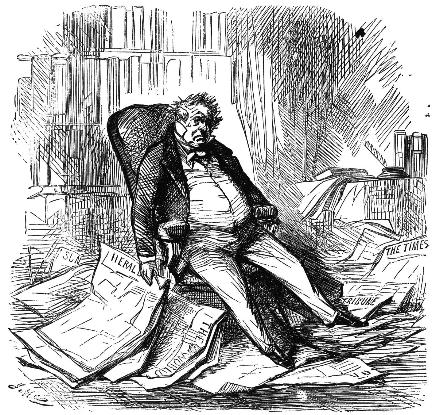
ORDER OF SERVICE
Entrance (silence)
(The officiant then organises the various sections of newspaper into the order in which they shall be read. Frivolities, such as ‘Gardening’, ‘Motoring’, and ‘Money & Business’, are discarded.)
First Reading: The Daily Telegraph, first section
Second Reading: The Financial Times, first section
First Glance: The Daily Telegraph, Weekend section (Rarely anything worth reading inside, but tradition requires at least a glance)
Third Reading: The Daily Telegraph, Property section
Nourishment: A sugar doughring from Fisher & Donaldson’s (Members of all newspaper-reading denominations are invited to partake, but are encouraged to abide by the rules of their respective communities)
Fourth Reading: The Financial Times, Weekend section (The best weekend section there is. Short and varied.)
Second Glance: The Daily Telegraph, Travel section (Ditto notes on Telegraph Weekend section)
Fifth Reading: FT Magazine
Final flip through the pages: (ruffle, ruffle, ruffle)
Exit. (The assembled then disperse and carry on with their day).
Warner on the Gotha
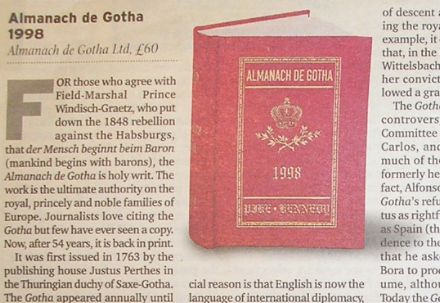
Whilst rummaging through my room at home in New York last week, I came across this article which I had cut out of the ill-fated European in 1998 written by none other than Mr. Gerald Warner, KM. I was fourteen years old in 1998 and the European folded about a year later. Click here to read in jpg form. (A large file, some browsers may require resizing to view the text at a readable size).
Dingbat Through the Ages

Newsdesigner.com has an interesting post enlightening us to the history of the ‘dingbat’, the vignette which can be found atop the International Herald Tribune.

The design first originated in the nameplate (also called, varyingly, the ‘masthead’, ‘banner’, or ‘flag’) of the New-York Tribune. The Tribune became the New York Herald Tribune, which my Aunt Naomi informs me was a very good newspaper while it lasted. The NYHT died in 1966, being merged into the ill-fated New York World Journal Tribune (aka the Widget) which only produced a few numbers before labor troubles killed it too.

The Herald Tribune, however, has two remnants which still exist today: the Paris edition (now the IHT) which continued under the auspices of the New York Times and the Washington Post, now solely owned by the Times; and New York magazine, which started out as a weekly supplement to the Herald Tribune.
Huzzah for the Sun
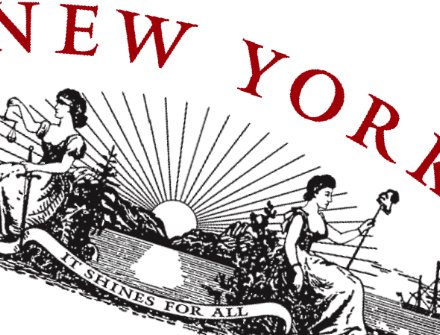
What?!? You still don’t read the New York Sun? Well you’re a fool then. I used to think the Daily Telegraph was the greatest newspaper in the English-speaking world, but now I think it’s got to be the New York Sun. It’s the quality hometown newspaper for the greatest town that ever was.
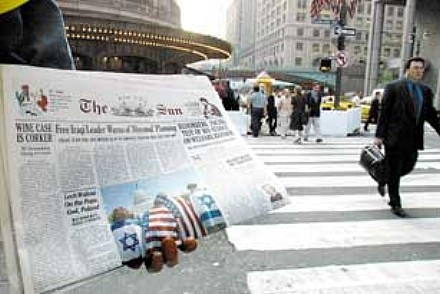 Almost like comparing the City of New York to the New York Times, the Sun is more colorful, less pretentious, loves America, and is a million times more interesting. The only way the Times is more like New York than the Sun is that the Times is so big you can never get through all of it at once.
Almost like comparing the City of New York to the New York Times, the Sun is more colorful, less pretentious, loves America, and is a million times more interesting. The only way the Times is more like New York than the Sun is that the Times is so big you can never get through all of it at once.
In yesterday’s Sun there was a fascinating profile of ‘the Rev’ (photo below), the men’s room attendant in the 21 Club. It was absolutely fascinating to find out about a gem of a man such as he. Reading the Times is arduous and depressing, whilst reading the Sun is informative and pleasing.
Purchasing an online subscription to the Sun was the wisest investment I think I’ve ever made. And economical as well at a mere $16.50 per quarter (with free 4-week trial period), allowing me to cancel for the quarter of the year I can actually buy the paper edition. Most satisfying.
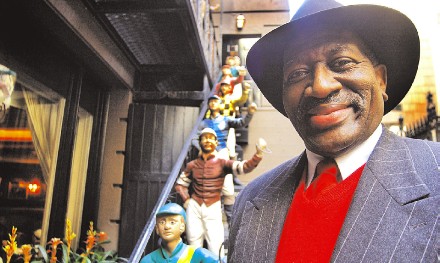
Another Broadsheet Bites the Dust
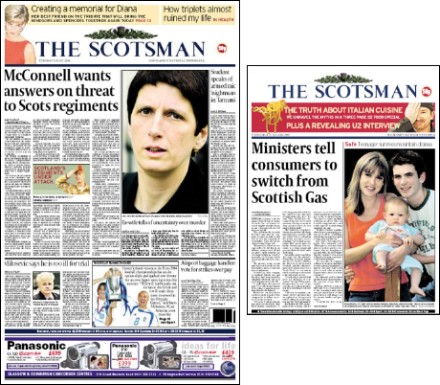
The Scotsman has given in to the current Fleet Street mania and become a tabloid. The newspaper had experimented with the tabloid size for its Saturday edition and then just a few days ago converted the weekday editions as well.
For my fellow Americans in the audience, a little explanation. Going tab is all the rage amongst respectable newspapers in Britain over the past year. The ancient Times of London comes in both broadsheet and tabloid format. The Independent was the first broadsheet to publish both a broadsheet and tabloid edition, and then decided to become a permanent tabloid. The Guardian, to my knowledge, has kept out of the tabloid fray, and the venerable Daily Telegraph remains commited to broadsheetism.
The benefits of publishing in tabloid size are that the newspaper is easier to handle and read. Financially, however, it means page size, and thus potential advertising space, is reduced by half.
I am not a fan of this tabloid revolution. I fantasize periodically about the Mitre being published in broadsheet format instead of A4. Perhaps my anti-tabloidism is culturally ingrained. After all, we Anglophones are used to the formula of broadsheet = trustworthy. This formula is not true, for example, in France, where the two main respectable newspapers, le Figaro and le Monde, are printed in a format slightly smaller than the standard US/UK tabloid.
Nonetheless, one of the aspects of broadsheets that I enjoy is that they aren’t easy to read on subways and whatnot. It’s best to sit down in a comfortable chair in a well-lit location and peruse the goings-on and thoughts of New York, the nation, and the world in the New York Sun than to get tiny bits of news in a “convenient” format.
Pensées des Journaux
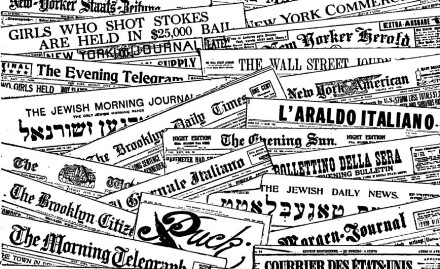
TODAY I WAS wondering how many daily newspapers there actually are in New York. I thought I knew all the English ones, the Spanish ones, and that there were a few Chinese ones as well. So my vague idea was somewhere around seven or eight.
After turning to the Encyclopedia of New York and the internet, by my count there are thirty-five dailies in New York, printed in nine different languages!
Eighteen English, five Chinese, three Korean, three Spanish, two Greek, one Italian, one Polish, one Russian, and one Ukrainian. That’s a very large number of newspapers for one city to sustain, though it ought to be remembered many of the language papers are purchased widely in other areas. Still, I wonder if Tokyo, Mexico, Seoul, Sao Paolo, Mumbai, and the other megacities out there have as many daily newspapers.
The eighteen English dailies by founding date are: (more…)
Quoth the Sun: ‘It Shines For All’

Have I ever mentioned how much I enjoy the New York Sun? It’s wonderful to come home to the Great Metropolis and read a broadsheet that doesn’t come off as sanctimonious and elitist (ahem, überliberal New York Times). I’m beginning to think the Sun may even be better than the Daily Telegraph. After all, I don’t believe I’ve ever seen any articles about ‘Posh and Becks’ in the New York Sun.
Like the Mitre, I dare say, it has a layout that is both contemporary and traditional. (There’s also a definite 1920’s aura to the Sun). And most unlike the Times, it is succint, taking up only twenty-two pages to the Times‘s one-hundred and sixteen. Mind you, I’d be the last to complain if it expanded in size. In fact, it could do to grow to perhaps thirty-something pages. But as our old headmaster used to say, to write, you have to be pompous. You have to believe others ought to be reading what you write. And at one-hundred-sixteen pages daily that means the New York Times is one of the most pompous newspapers around. No shocker there.
Search
Instagram: @andcusack
Click here for my Instagram photos.Most Recent Posts
- A Christmas Gift from the Governor December 24, 2024
- Oude Kerk, Amsterdam December 24, 2024
- Gellner’s Prague December 19, 2024
- Monsieur Bayrou December 18, 2024
- Dempsey Heiner, Art Critic December 17, 2024
Most Recent Comments
Book Wishlist
Monthly Archives
Categories


